John Nieber
Hierarchically Disentangled Recurrent Network for Factorizing System Dynamics of Multi-scale Systems
Jul 29, 2024Abstract:We present a knowledge-guided machine learning (KGML) framework for modeling multi-scale processes, and study its performance in the context of streamflow forecasting in hydrology. Specifically, we propose a novel hierarchical recurrent neural architecture that factorizes the system dynamics at multiple temporal scales and captures their interactions. This framework consists of an inverse and a forward model. The inverse model is used to empirically resolve the system's temporal modes from data (physical model simulations, observed data, or a combination of them from the past), and these states are then used in the forward model to predict streamflow. In a hydrological system, these modes can represent different processes, evolving at different temporal scales (e.g., slow: groundwater recharge and baseflow vs. fast: surface runoff due to extreme rainfall). A key advantage of our framework is that once trained, it can incorporate new observations into the model's context (internal state) without expensive optimization approaches (e.g., EnKF) that are traditionally used in physical sciences for data assimilation. Experiments with several river catchments from the NWS NCRFC region show the efficacy of this ML-based data assimilation framework compared to standard baselines, especially for basins that have a long history of observations. Even for basins that have a shorter observation history, we present two orthogonal strategies of training our FHNN framework: (a) using simulation data from imperfect simulations and (b) using observation data from multiple basins to build a global model. We show that both of these strategies (that can be used individually or together) are highly effective in mitigating the lack of training data. The improvement in forecast accuracy is particularly noteworthy for basins where local models perform poorly because of data sparsity.
Uncertainty Quantification in Inverse Models in Hydrology
Oct 03, 2023



Abstract:In hydrology, modeling streamflow remains a challenging task due to the limited availability of basin characteristics information such as soil geology and geomorphology. These characteristics may be noisy due to measurement errors or may be missing altogether. To overcome this challenge, we propose a knowledge-guided, probabilistic inverse modeling method for recovering physical characteristics from streamflow and weather data, which are more readily available. We compare our framework with state-of-the-art inverse models for estimating river basin characteristics. We also show that these estimates offer improvement in streamflow modeling as opposed to using the original basin characteristic values. Our inverse model offers 3\% improvement in R$^2$ for the inverse model (basin characteristic estimation) and 6\% for the forward model (streamflow prediction). Our framework also offers improved explainability since it can quantify uncertainty in both the inverse and the forward model. Uncertainty quantification plays a pivotal role in improving the explainability of machine learning models by providing additional insights into the reliability and limitations of model predictions. In our analysis, we assess the quality of the uncertainty estimates. Compared to baseline uncertainty quantification methods, our framework offers 10\% improvement in the dispersion of epistemic uncertainty and 13\% improvement in coverage rate. This information can help stakeholders understand the level of uncertainty associated with the predictions and provide a more comprehensive view of the potential outcomes.
Mini-Batch Learning Strategies for modeling long term temporal dependencies: A study in environmental applications
Oct 15, 2022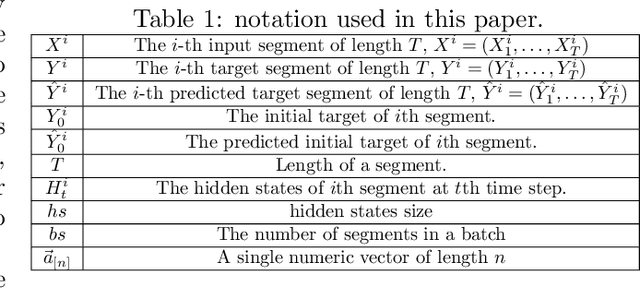
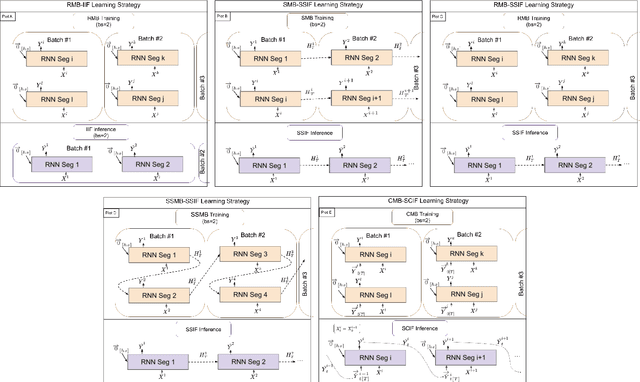
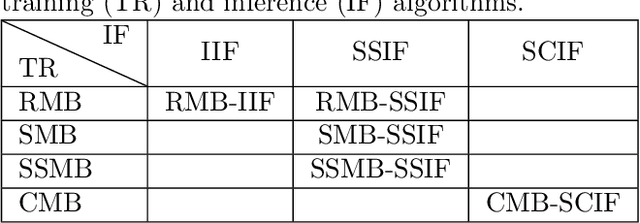
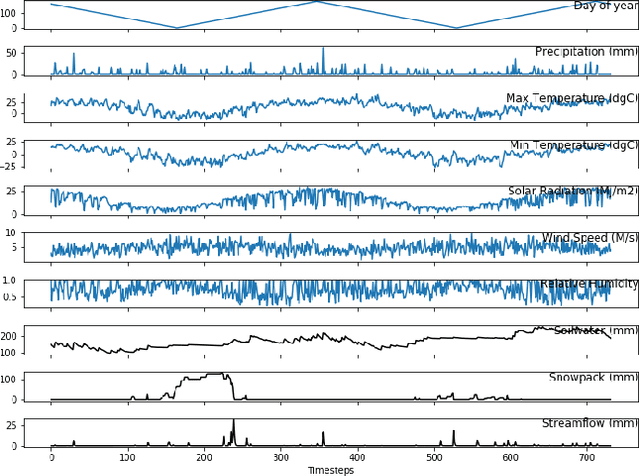
Abstract:In many environmental applications, recurrent neural networks (RNNs) are often used to model physical variables with long temporal dependencies. However, due to mini-batch training, temporal relationships between training segments within the batch (intra-batch) as well as between batches (inter-batch) are not considered, which can lead to limited performance. Stateful RNNs aim to address this issue by passing hidden states between batches. Since Stateful RNNs ignore intra-batch temporal dependency, there exists a trade-off between training stability and capturing temporal dependency. In this paper, we provide a quantitative comparison of different Stateful RNN modeling strategies, and propose two strategies to enforce both intra- and inter-batch temporal dependency. First, we extend Stateful RNNs by defining a batch as a temporally ordered set of training segments, which enables intra-batch sharing of temporal information. While this approach significantly improves the performance, it leads to much larger training times due to highly sequential training. To address this issue, we further propose a new strategy which augments a training segment with an initial value of the target variable from the timestep right before the starting of the training segment. In other words, we provide an initial value of the target variable as additional input so that the network can focus on learning changes relative to that initial value. By using this strategy, samples can be passed in any order (mini-batch training) which significantly reduces the training time while maintaining the performance. In demonstrating our approach in hydrological modeling, we observe that the most significant gains in predictive accuracy occur when these methods are applied to state variables whose values change more slowly, such as soil water and snowpack, rather than continuously moving flux variables such as streamflow.
Probabilistic Inverse Modeling: An Application in Hydrology
Oct 12, 2022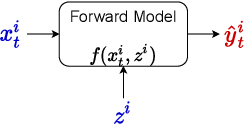

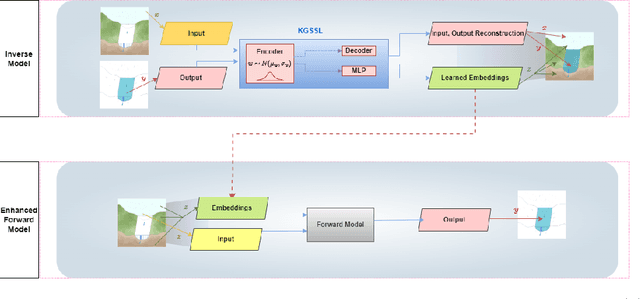

Abstract:The astounding success of these methods has made it imperative to obtain more explainable and trustworthy estimates from these models. In hydrology, basin characteristics can be noisy or missing, impacting streamflow prediction. For solving inverse problems in such applications, ensuring explainability is pivotal for tackling issues relating to data bias and large search space. We propose a probabilistic inverse model framework that can reconstruct robust hydrology basin characteristics from dynamic input weather driver and streamflow response data. We address two aspects of building more explainable inverse models, uncertainty estimation and robustness. This can help improve the trust of water managers, handling of noisy data and reduce costs. We propose uncertainty based learning method that offers 6\% improvement in $R^2$ for streamflow prediction (forward modeling) from inverse model inferred basin characteristic estimates, 17\% reduction in uncertainty (40\% in presence of noise) and 4\% higher coverage rate for basin characteristics.
Physics Guided Machine Learning Methods for Hydrology
Dec 02, 2020

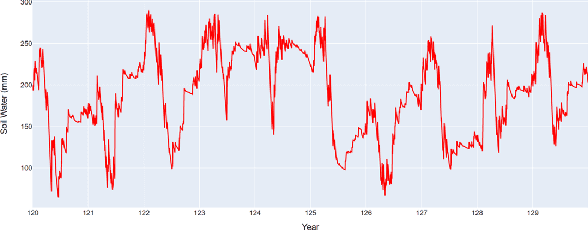

Abstract:Streamflow prediction is one of the key challenges in the field of hydrology due to the complex interplay between multiple non-linear physical mechanisms behind streamflow generation. While physically-based models are rooted in rich understanding of the physical processes, a significant performance gap still remains which can be potentially addressed by leveraging the recent advances in machine learning. The goal of this work is to incorporate our understanding of physical processes and constraints in hydrology into machine learning algorithms, and thus bridge the performance gap while reducing the need for large amounts of data compared to traditional data-driven approaches. In particular, we propose an LSTM based deep learning architecture that is coupled with SWAT (Soil and Water Assessment Tool), an hydrology model that is in wide use today. The key idea of the approach is to model auxiliary intermediate processes that connect weather drivers to streamflow, rather than directly mapping runoff from weather variables which is what a deep learning architecture without physical insight will do. The efficacy of the approach is being analyzed on several small catchments located in the South Branch of the Root River Watershed in southeast Minnesota. Apart from observation data on runoff, the approach also leverages a 200-year synthetic dataset generated by SWAT to improve the performance while reducing convergence time. In the early phases of this study, simpler versions of the physics guided deep learning architectures are being used to achieve a system understanding of the coupling of physics and machine learning. As more complexity is introduced into the present implementation, the framework will be able to generalize to more sophisticated cases where spatial heterogeneity is present.
 Add to Chrome
Add to Chrome Add to Firefox
Add to Firefox Add to Edge
Add to Edge